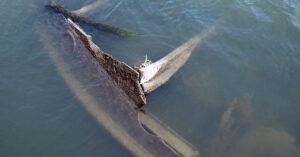
U.S. Coast Guard Offloads Over 4,125 Pounds Of Drugs Worth $54 Million Seized In Caribbean Sea
September 11, 2024
U.S. & U.K. Sanction 5 Russian Cargo Ships For Transporting Military Supplies From Iran To Russia
September 11, 2024

The explosives-loaded World War II era Nazi shipwrecks have emerged in the River Danube due to severe drought conditions in Eastern Europe.
The historic drop in water levels in July and August revealed the wrecks near Serbia’s river port town of Prahovo and Hungary’s Danube-Drava National Park near Mohacs.
The ships, scuttled by Nazi Germany’s Black Sea fleet in 1944 as they retreated from approaching Soviet forces, have been revealed to low water levels, which dropped to 1.5 meters in Hungary’s Mohacs and 1.17 meters in Budapest earlier this week.
These wrecks, some of which still have their original turrets, command bridges, and twisted hulls, might risk river traffic during low water levels.
In Hungary, the wrecks of four warships dating back to before 1950 were discovered. Endre Sztellik, a guard at the Danube-Drava National Park, said one of the ships remained a mystery, adding that they still don’t know what it is exactly. However, Sztellik was concerned about parts of the shipwreck disappearing as people showed interest in it.
The drought has had a major impact on the region. The European climate service company Copernicus reported that Eastern Europe is facing extreme drought conditions, which badly impact crops and vegetation.
While the Danube’s water level in Budapest is 1.17 meters, it remains higher than the all-time low of 0.4 meters reached in October 2018.
Rainfall is expected to bring some relief. The water level at Mohacs will rise to about three meters by the weekend, possibly submerging the ships once again.
The drought has also had an impact in Poland, where the Vistula River has reached a record low. This has exposed sandbanks in Warsaw and left the water so shallow that a moose was spotted walking across it in the countryside.
Reference: Reuters, CNN
Explosives Loaded Nazi Ships That Sank In WWII Resurface In Danube River As Water Levels Drop appeared first on Marine Insight – The Maritime Industry Guide
Source: Maritime Shipping News


